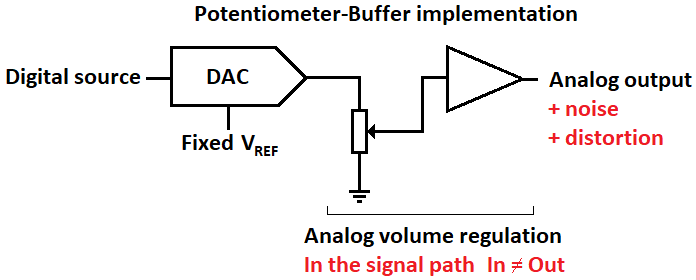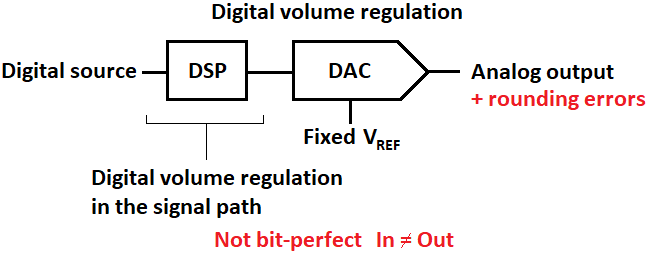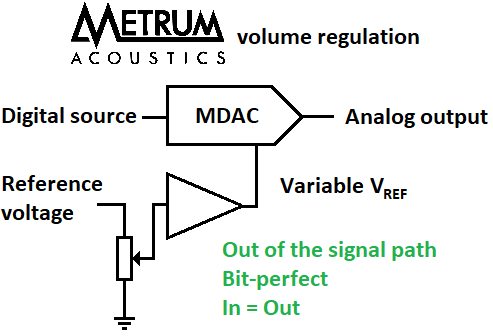Metrum Newsletter - October 2023

Volume Control Secrets with DACs

Volume Control Secrets with DACs
Click here to scroll to email omitted details

Fall is here (at least in the Northern Hemisphere), the season to enjoy the colors of the leaves changing, going more inward and taking time for introspection. The changing of seasons touches all of us, so if you could use a little cheer-up please remember that every mood can be improved by beautiful Music. Time to take good care of yourself, use a Metrum or Sonnet DAC to be closer to your musical friends or even share the experience with your real-life friends. For us, this is also an opportunity to go inward and explain a little more about the inner workings of our volume control.
Traditional volume control
"An imperfect situation"
In the ideal world, volume control doesn't add or remove anything from the original signal. Also, the ear and hearing system would be perfectly linear (which is not the case. Thank you, Fletcher & Munson, 1933). We'll stick with the electrical part for this newsletter. Traditionally, a volume knob (potentiometer) with a buffer amplifier was implemented to regulate volume. The buffer was added to avoid coloration of sound when volume was low.

DAC with analog volume control using potentiometer & buffer
As a potentiometer (or other resistance element) and buffer amplifier introduce noise and distortion, these need to be as neutral as possible. A buffer that is a "straight wire with gain" is needed. Unfortunately, wires with gain don't exist and every electrical component can make for a different sound. For this reason, tweakers and DIYers switch opamps or roll tubes, while only exotic resistors and capacitors lead to audio Nirvana.
A philosophy that is common in the audio world is called "out of the signal path". When electrical components are "out" of the signal path, like capacitors, they don't influence the sound as much as when they are "in" the signal path. As an audio company, this is a design choice, partly defining the sound-signature of the audio devices. A short signal path with as few components as possible is preferred. Therefore, tube amplifiers are usually simple in setup and sound well. We digress into the analog world... back to volume control.
Digital volume control
"A worse solution"
Another option for volume regulation is in the digital domain. This implementation introduces quantization (round-off) problems leading to a loss of fine resolution. The original signal needs to be "recoded" with a calculation to fit the new – lower volume – waveform, with round-off errors as a consequence. The most ubiquitous form of this type of volume regulation is in the volume control built into your phone/computer. We understand that the user experience is also important, but when listening critically it just doesn't fly: bit-perfect playback is no longer possible.

Digital volume control done with a DSP before DAC with fixed VREF
In conclusion, controlling volume was always about taste and choosing the lesser evil. Until... you don't have to choose between evils. So, how can we regulate volume using the "straight wire with gain" and "out of the signal path" philosophies without changing the bits?
Metrum volume control
"A bit-perfect resolution"
The volume control in the Metrum Jade and Adagio, as well as the Sonnet Morpheus and Pasithea, use a different paradigm. In our digital pre-amplifiers, the volume control is completely out of the Analog signal path. The Metrum way gives an unaltered bit-perfect signal with full resolution that arrives at the DAC modules (unlike in DSP-based volume controls), regardless of the volume setting.

Metrum Volume Control using variable VREF
How does it work? The R2R ladder divides its input reference voltage by setting the internal switches to the code that is your sample (digital, so ones and zeros). The R2R ladder directly makes the waveform (and thus sound) using different settings of the digitally controlled switches over time. The input of the ladder (Variable VREF) is directly driven by a voltage. Traditionally this is a fixed voltage, but in our case this voltage cán be lowered, resulting in a lower musical output signal.
The reference voltage input (Variable Vref) of the Multiplying DAC (MDAC) is driven by a potentiometer-buffer combination that is out of the signal path. This technique makes sure you have every bit of True to Nature Music in and you can enjoy all your Music in full resolution, at all volume settings.
The volume regulation technique we use is unique and can't be implemented in off-the-shelf audio DAC chips, because they either don't use the R2R architecture, or they only accept a fixed reference voltage. This means the reference voltage – and consequently the volume – can't be altered in the same way.
Some audio DAC chips implement analog volume control and use a resistance ladder at the output (if that option is present at all). This method is "in the signal path" and has its drawbacks as discussed earlier. Remember that a resistance ladder is already present in an R2R DAC? Why use two resistance ladders if you only need one? We have access to the reference input of the ladder, so we can just steer a reference voltage there. Less is more :)
So, the bits that go into the DAC are the same bits that reach the DAC modules inside? Yes, our architecture uses a straight 'bit pipe': Non OverSampling (NOS) and filterless all the way! And it is fast too! More on NOS (our way to guarantee our True to Nature sound) in a future newsletter.
Then what about switching noise? Yes! At very low volumes switching noise can give rise to higher distortion figures. In real life, our volume control delivers a carefully chosen attenuation range of ~60dB. This is more than enough range to change the volume from a small and delicate pianissimo to a very big Forte, while keeping the effects of switching noise at a minimum. The better than -140dB noise floor of our DACs speaks for itself.
Please note that our volume control is in the Analog domain, but in our implementation can't be used to control an analog musical input since it already controls a DC reference voltage. Therefore, it is not so easy to implement an extra analog input that also has volume control. For this reason, the Adagio, Jade, Morpheus and Pasithea are called digital pre-amplifiers.
For the Techies
A look under the hood of R2R DAC technology shows that the musical signal is built up from a binary code (PCM, e.g. your sample) that sets internal switches of the R2R ladder to the correct position (either one or zero), and thus output voltage. Doing this for a sequence of samples over an amount of time gives a reconstruction of the original musical signal in time: the voltage level is different per sample, so the signal changes over time. The switches on the right side have the largest influence on the output voltage and are therefore called the Most Significant Bits (MSB). The switches on the left side are Least Significant (LSB). Now, the unique functionality we offer is that we can set the input voltage for the whole R2R ladder. So if we lower the voltage on the input of the ladder, a lower – but still musically modulated – output can be obtained. A higher reference voltage evidently leads to a higher output volume. The 'amplifier' at the end of the R2R ladder converts current to voltage. Current is a fast medium, where voltage is needed at the output of the DAC. Using a current to voltage converting amplifier then helps to keep the speed, while keeping noise and distortion low.

R2R ladder showing how Metrum volume control is implemented
Closing words
Enjoy the colors of autumn without coloration, paint your musical palette with all the colors of the wind. Take five and invite Brubeck and friends for some five-quarter genius. Musicians and their Music make the Autumn season so much more enjoyable. Pour yourself a cup of something wonderful and take good care of yourself by immersing yourself in a musical treat that our filterless NOS DACs can deliver; with neutral volume control. You now know how that works...
If you are interested, our new order portal supports all of our brands (Metrum, Sonnet and Acelec) so you or your dealer can order any device we carry, even in the mix. So you can order a Metrum Ambre alongside a Sonnet Pasithea without problems (they happily interconnect too by the way). We made sure to have enough stock for all of our most popular models and will produce even more equipment before the end of the year. Holidays are coming, and so is Winter :)
Our engineers are hard at work on something new, which may be the focus of a not-too-distant future newsletter.
Keep listening to beautiful Music, we'll talk soon...

Team Metrum Acoustics








